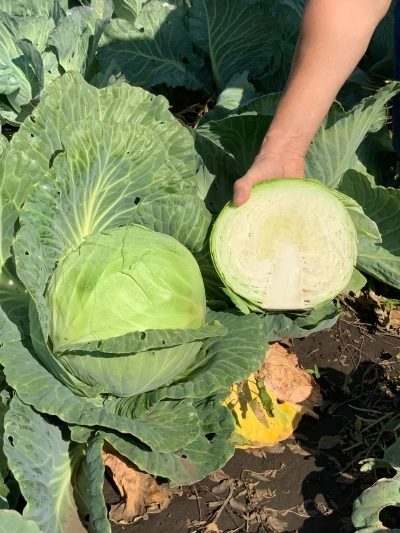
- Authors: Kryuchkov A.V., Monakhos G.F., Patsuria D.V., Suddenko V.G., Alekseev Yu.B.
- Year of approval: 1998
- Appointment: for fresh consumption, for fermentation
- Leaf rosette: raised
- Leaf size: medium size
- Leaf color: gray-green
- Sheet surface: convex, slightly bubbly
- Outside stump: 17 cm
- Internal stump: short
- Weight, kg: 3,7-4,3
Cabbage variety Semko Yubileiny 217 has been popular with gardeners for over 20 years. The advantages of the culture include its high yield, excellent taste, cold resistance and resistance to many diseases.
Breeding history
Variety Semko Yubileiny 217 was bred in Russia on the basis of the Moscow experimental breeding station named after V.I. N.N. Timofeeva. AV Kryuchkov, GF Monakhos, DV Patsuria, VG Suddenko and Yu. B. Alekseev took part in the creation of the hybrid. In 1997, an application was submitted for admission, and in 1998 the variety was included in the register of approved crops.
Description of the variety
This culture is a white cabbage. It belongs to the first generation F1 hybrids. Recommended for outdoor cultivation. It is characterized by high yield and good transportability. Resistant to different climatic conditions, recommended for cultivation throughout Russia, including the regions of Siberia, the Urals and the Far East.
Characteristics of the appearance of the plant and heads of cabbage
Cabbage Semko Jubilee 217 has a medium-sized raised leaf rosette. The leaves are medium-sized, gray-green in color, with a convex slightly bubbly surface and a strong waxy bloom. They are broadly ovate in shape, with a medium wavy edge. The outer stump reaches 17 cm, the inner one is short.
Heads of cabbage of this variety are characterized by an oval shape and semi-covered. They are green on the outside, whitish on the inside. The mass of one head of cabbage is 3.7-4.3 kg.
Purpose and taste
Heads of cabbage are described as firm. They have a crisp texture and good cracking resistance. Cabbage Semko Yubileiny 217 is famous for its excellent taste. It is recommended for fresh consumption, ideal for fermentation. It can be stored for about 5 months without loss of taste and presentation.
Ripening terms
This culture belongs to the mid-season. The period from full germination to technical ripeness is 130 days. Mass harvesting takes place, as a rule, in October.
Yield
The variety is characterized by stable high yields. The average yield is 8-10 kg / m2 and 755-877 kg / ha. Cabbage variety Semko Yubileiny 217 ripens amicably and requires harvesting all plantings at once.
Growing and care
Cabbage Semko Jubilee is easy to cultivate, but you should pay attention to the following points.
- Seeds for seedlings are planted in a cool greenhouse in mid-March to a depth of about 1 cm.
- At the age of 45 days, young plants can be planted in open ground, following the planting scheme 60-70x50 cm.
- Sunny areas with loamy or sandy soils are best suited for the Semko Yubileiny 217 variety. Heavy soil can be diluted with sand, and sawdust should be added to black soil.
- The recommended soil acidity is 6-7 pH.
- This culture has a short branched root, therefore, after planting seedlings in the beds, it is imperative to huddle the plants.
- The variety requires regular abundant watering (up to 20-30 liters per 1 m2).
- As a top dressing, it is better to use not organic matter, but complex mineral fertilizers.
- It should be noted that this cabbage tolerates autumn frosts well, so you should not rush to harvest.

To grow a rich cabbage crop, you need to know when and how to plant this crop outdoors. Planting dates are determined depending on the variety. It is also necessary to properly prepare the soil and follow the rules of crop rotation.



Cabbage requires particularly careful care when growing. The plant quickly absorbs nutrients, so the soil needs to be enriched regularly. Adequate amounts of minerals, organics and nitrogen must be provided. Some products can be purchased at the store, while others are easy to make at home.
Disease and pest resistance
A thick waxy bloom on the leaves of Semko Yubileiny 217 reliably protects plants from many diseases and pests. The variety is characterized by resistance to vascular bacteriosis and fusarium. For the prevention of a disease such as cabbage keel, it is recommended to carry out treatment with fungicides. Such drugs as "Fitosporin-M", "Trichodermin", "Previkur" have proven themselves well.

Cabbage is a very popular horticultural crop. But growing a good, large and tasty cabbage is sometimes very difficult, because it is often affected by a huge number of diseases and pests. The main role in the cultivation of this vegetable is played by regular prevention, which helps to get a rich harvest, and prevent the occurrence of diseases and the invasion of harmful insects. It is very important to start treatment as early as possible, otherwise there is a risk of spreading the infection to still unaffected plants.























































































